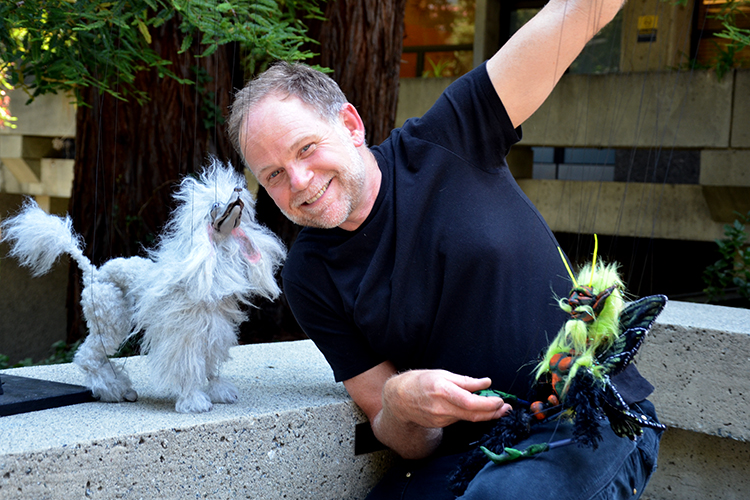Podcast transcript: Bringing people together, one puppet at a time

July 25, 2018
This is Fiat Vox, a podcast that gives you an inside look at why people around the world are talking about UC Berkeley. I’m Anne Brice, a reporter for Berkeley News in the Office of Communications and Public Affairs.
Today we’re talking with Glynn Bartlett, a scenic artist for the Department of Theater, Dance and Performance Studies at UC Berkeley, about the power of puppetry to bring people together.
[Natural sound from a video about the performance: Glynn working in the studio]
Carving a giant tortoise head, Glynn Bartlett is in his element. It’s 2015 and he’s in South Africa, volunteering for Handspring Puppet Company.
He first saw the company perform at UC Berkeley through Cal Performances earlier that year and just knew right away that he wanted to work with them.
Glynn Bartlett: Handspring tends to do puppetry that requires two to three puppeteers to manipulate a puppet. You have to become one organism to bring this one puppet to life.
So, he packed his bags and traveled to Barrydale, a small village in Western Cape Province, where Handspring was building puppets for the village’s annual puppet parade and play.
It’s an event that happens every year on December 16 — the Day of Reconciliation.
[Music: “Rose Ornamental” by Blue Dot Sessions]
It’s a public holiday that began in 1994 after the end of apartheid to foster reconciliation and national unity.
Although Barrydale is small, it remains divided — with whites living on one side of a big hill and non-whites on the other.
To help bring both sides together, the Handspring Trust for Puppetry Arts partnered with a youth organization, Net Vir Pret, which means “just for fun” in Afrikaans. And together, in 2009, they began putting on the Day of Reconciliation’s parade and play.
[Natural sound from video: Music from the performance]
Bartlett: There’s just something really magical about puppets that bring people together and it just transcends all of those things that get in our way as human beings. And it just gives us a whole other way to relate to one another in a way that’s very true and real.
As a scenic artist for the Department of Theater, Dance and Performance Studies at UC Berkeley, Glynn teaches students how to paint the sets for their productions.
But in his spare time, he builds puppets.
Anne Brice (host): Could you describe your puppets over here?
Bartlett: So I have three marionettes that are hanging before us. The one in the center is actually, he’s a butterfly faerie. I actually created him to take with me to South Africa. He’s been more places as a puppet than a lot of people have been. He’s pretty well-traveled.
He’s a member of the San Francisco Bay Area Puppeteers Guild and of Puppeteers of America. He says decades of being in the puppet community have shown him the deep desire to connect with people that a lot puppeteers share.
Bartlett: I think part of it is because so many puppeteers do shows that are oriented towards children and so many puppeteers kind of get into puppetry because they want to change the energy of the world. They want to educate or build community or they just want to plain entertain and make people happy.
But, he says, a puppeteer also needs to have a thick skin and know that puppets aren’t for everyone.
Bartlett: You have to be kind of okay about being considered a freak because a lot of people think puppeteers are weird. That puppets are weird. And then there are other people who just think they’re magical.
[Music: “Arizona Moon” by Blue Dot Sessions]
Although there isn’t a formal puppeteering class at Berkeley, Glynn finds ways to work in puppets when he can.
Last year, he held a one-day theater puppet-making workshop for students in theater, dance and performance studies. And he was an adviser for students who built puppets for the department’s production of The Dream of Kitamura, by professor and leading playwright Philip Kan Gotanda.
When he retires, however, Glynn’s plan is to have a second career in puppetry.
Bartlett: One of the great things about puppetry is it’s not necessarily an age-oriented career. I mean, there are a lot of puppeteers who puppeteer well into their 80s or 90s. In fact, there’s a woman who is part of the Puppeteers of America who is 103 years old and she still performs at the festivals.
He’s been writing a version of Jack and the Beanstalk — a sort of American tale. He wants to take his shows on the road and tour, bringing people together to learn and have a good time.
For Berkeley News, I’m Anne Brice.
You can subscribe to the Fiat Vox podcast on Apple Podcasts or Stitcher or wherever you get your podcasts. For more UC Berkeley news, you can visit news.berkeley.edu. If you have a great story idea, send us an email at [email protected].